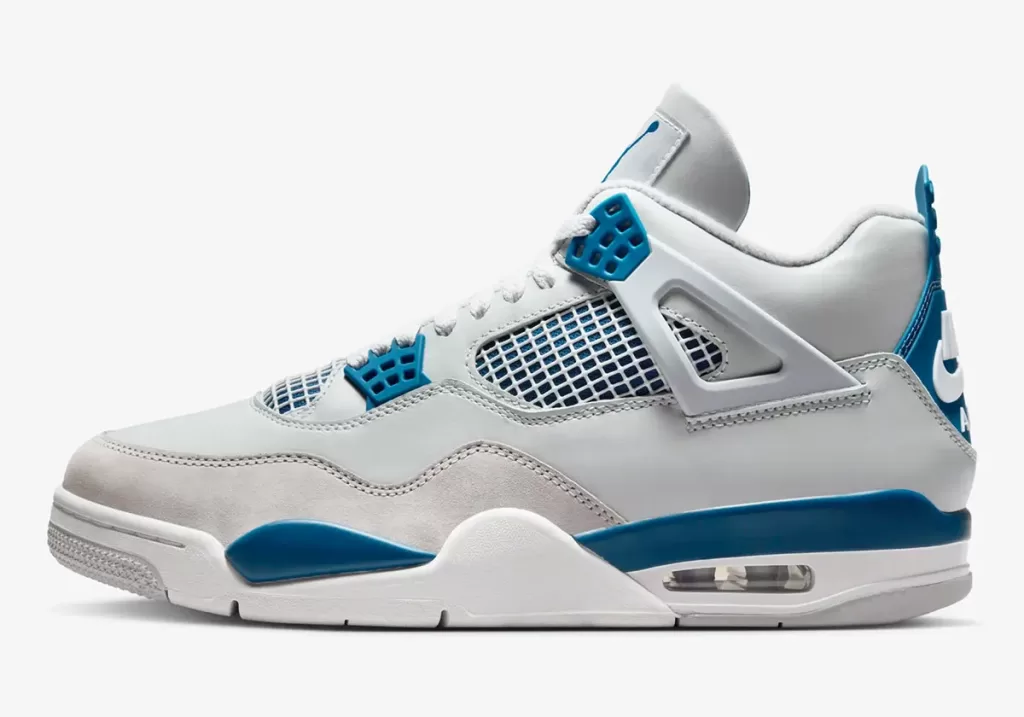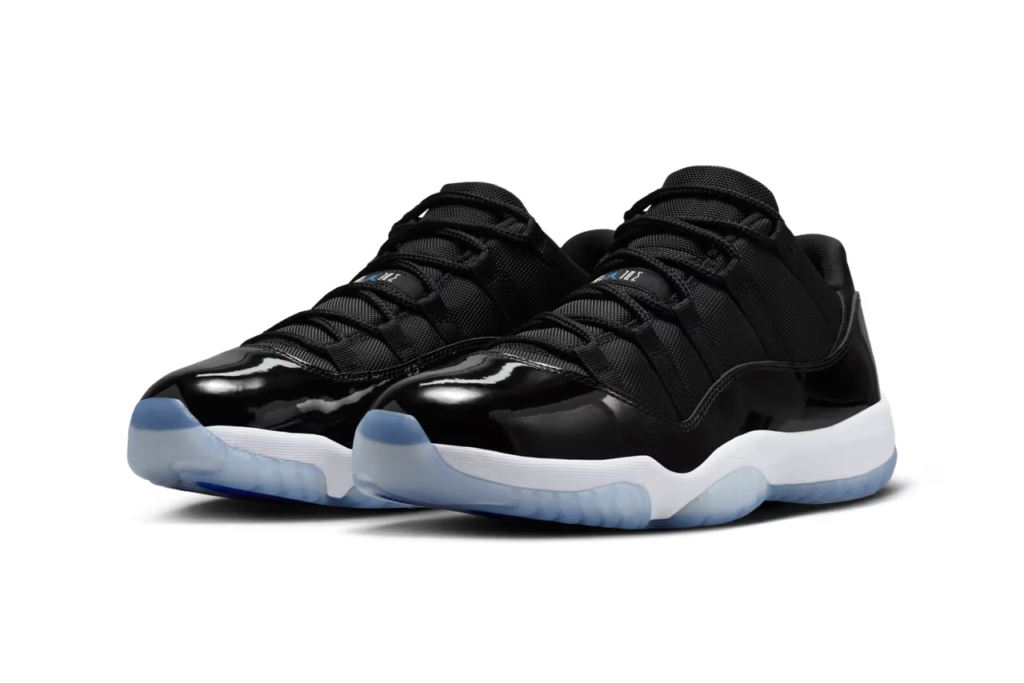Air Jordan sneakers have extended beyond the basketball court to become cultural icons for over three decades. From the game-changing Air Jordan 1 to the championship-winning Air Jordan 14, each sneaker tells a story of innovation, design, and Michael Jordan’s relentless pursuit of greatness.
This guide is your one-stop shop for everything you need about the first 14 Air Jordan signature shoes. We’ll uncover each model’s history, design details, and cultural impact, helping you understand why these sneakers continue to reign supreme. So, let’s get started!
Air Jordan 1
The Air Jordan 1, launched in 1985, is not just a sneaker; it’s a cultural phenomenon. Designed by Peter Moore, the shoe was initially banned by the NBA for its bold, non-regulation black and red colourway. This only fueled its popularity, making it a coveted symbol of rebellion and street style. The Air Jordan 1 features a high-top silhouette with premium leather construction, offering style and support.
Beyond its iconic status, the Air Jordan 1 remains a versatile shoe. The simple design allows for endless colour combinations. However, classic colorways like “Chicago” and “Bred” retain their timeless appeal, ensuring the Air Jordan 1’s place as a legend in footwear history.

Air Jordan 2
Following the success of the Air Jordan 1, the Air Jordan 2 debuted in 1986 with a daring design by Bruce Kilgore. It featured Italian leather and a sleek, no-lace design with Velcro straps and without a swoosh.
However, the Air Jordan 2 wasn’t a slam dunk for Michael Jordan himself. He reportedly found the soles inflexible, and the unique style wasn’t quite to his taste. Despite this, he averaged 3,000 points that season, a record for most per game in the modern NBA era. It was priced at $100 in 1986, nearly double the cost of the Air Jordan 1, and was a tough sell for fans.


Air Jordan 3
The Air Jordan 3, released in 1988, was designed by the legendary Tinker Hatfield. It was the first Jordan shoe to feature visible Nike Air cushioning in the heel, a technology synonymous with the brand. The AJ3 also debuted the now-iconic “elephant print” on the mudguard and toe box. Hatfield also introduced a new Jumpman logo on the tongue, further solidifying the brand’s visual identity.
On the court, the Air Jordan 3 made MJ win his first NBA Slam Dunk Contest and MVP honours while wearing the shoe, boosting its association with peak performance.

Air Jordan 4
The Air Jordan 4, released in 1989, built upon the success of its predecessor. While still designed by Tinker Hatfield, the AJ4 took on a more streamlined and lightweight look, with mesh panels on the upper for improved breathability. The iconic “wings” on the midsole offered additional ankle support and became a signature design element.
The Air Jordan 4 rose above the basketball court, finding favour in hip-hop thanks to its stylish design. Its most famous on-screen appearance may be in Spike Lee’s film “Do the Right Thing,” enhanced its cultural impact.

Air Jordan 5
In 1990, Tinker Hatfield once again pushed the boundaries with the Air Jordan 5. This design featured a much higher cut inspired by the look of a World War II fighter jet. The shoe boasted a luxurious aesthetic with premium materials and a reflective 3M tongue, cementing the Air Jordan line’s status as a luxury basketball sneaker.
This innovation paid off for Michael Jordan, as he famously scored a career-high 69 points while wearing the Air Jordan 5 against the Cleveland Cavaliers. The Air Jordan 5 is coveted for its unique style and historical significance.

Air Jordan 6
The Air Jordan 6 was released in 1991 and designed by Tinker Hatfield. It was the shoe Michael wore during his first NBA championship win. The design inspired a German sports car, the Porsche 911, offering a sleek and stylish look.
The Air Jordan 6’s popularity goes beyond the court. Virgil Abloh, a fashion icon, named it his favourite Air Jordan, and it has had many collaborations, like the “Doernbecher” edition dedicated to fighting childhood cancer. With its championship pedigree and timeless design, the Air Jordan 6 stays a favourite among sneakerheads.

Air Jordan 7
The Air Jordan 7, released in 1992, marked a significant year for Michael Jordan. Having secured his first NBA championship and nearing GOAT status, Tinker Hatfield drew inspiration from global influences. The upper, multicoloured tongue print, and outsole showcased African tribal artwork, reflecting Jordan’s growing international influence.
This era also saw a legendary ad campaign with Bugs Bunny in animated commercials, making the Air Jordan 7 campaign unforgettable. Worn by Jordan during the Dream Team’s 1992 Olympic gold medal run and the Chicago Bulls’ repeat championship victory, the Air Jordan 7 embodied MJ’s global dominance.

Air Jordan 8
The Air Jordan 8, released in 1993, marked a bittersweet moment for Jordan Brand. Designed by Tinker Hatfield, it was the final Air Jordan sneaker before Michael Jordan’s shocking retirement from basketball.
However, the shoe’s legacy is undeniable. Michael Jordan wore the Air Jordan 8 as he secured his third consecutive NBA championship title against the Phoenix Suns in 1993. The Air Jordan 8 serves as a reminder of Jordan’s unmatched competitive spirit and the era-defining three-peat championship run he achieved with the Chicago Bulls.

Air Jordan 9
The Air Jordan 9, released in 1993, marked a crossroads for the brand. Designed by Tinker Hatfield, it was meant as a farewell to Michael Jordan during his first retirement. The shoe featured a neoprene bootie and a hidden lacing system, offering a sleek design.
However, the Air Jordan 9’s story doesn’t end there. By the time the shoe hit shelves, Michael Jordan had announced his return to the NBA. The Air Jordan 9 symbolised his comeback, blending farewell with a new chapter in his career and adding a unique twist to its legacy.

Air Jordan 10
The Air Jordan 10, released in 1994, marked a shift in design philosophy. With Tinker Hatfield stepping back, the Nike team designed this iteration. The shoe honoured Michael Jordan’s ten career milestones, featuring a unique lacing system and durable rubber outsole.
Though not designed by Hatfield, the Air Jordan 10 embodied innovation. The memorable “Double Nickel” colourway commemorated Jordan’s 55-point game against the Knicks. While it may not hold the same cultural weight as its predecessors, the Air Jordan 10 remains significant in the Jordan Brand timeline.

Air Jordan 11
The Air Jordan 11, released in 1995 and designed by Tinker Hatfield, is considered the pinnacle of the brand. This shoe marked Michael Jordan’s return after his first retirement. It introduced a full-length Zoom Air cushioning system for exceptional responsiveness and impact protection.
The Air Jordan 11 also redefined style with its iconic patent leather mudguard, inspired by a sleek Italian shoe. Its association with the movie “Space Jam” cemented its pop culture status. Classic colorways like “Bred” and “Concord” remain coveted by collectors, solidifying the Air Jordan 11’s cultural and basketball legacy.

Air Jordan 12
The Air Jordan 12, released in 1996 and designed by Tinker Hatfield, holds a special place in Michael Jordan’s legacy. He wore it during his historic 72-win season with the Bulls, leading to his fourth NBA championship.
Inspired by the Japanese Rising Sun, the design initially drew mixed reactions. Some appreciated the cultural reference, while others found it controversial. Despite this, the shoe’s performance features, like Zoom Air cushioning and a comfortable fit, won fans over.

Air Jordan 13
The Air Jordan 13, debuting in 1997 under Tinker Hatfield’s design, marked a pivotal return for the brand. Inspired by the sleekness of a black panther, it featured a distinctive paw-like outsole and a holographic image of Michael Jordan mid-leap. It also boasted encapsulated air cushioning for impact absorption and a supportive upper for agility.
Despite initial scepticism, its unconventional design soared to legendary status, fueled by sought-after colourways like “He Got Game” and “Flint.” Revered by sneakerheads, the Air Jordan 13 is a testament to Jordan’s enduring legacy.

Air Jordan 14
The Air Jordan 14, introduced in 1998 under Tinker Hatfield’s design, marked Michael Jordan’s poignant farewell with the Chicago Bulls. Accompanying his final season and sixth NBA championship, its sleek silhouette drew inspiration from the Larry O’Brien NBA Championship trophy, featuring gold accents on the heel.
While performance remained paramount, boasting Zoom Air cushioning and support, the Air Jordan 14 also exudes luxury with premium materials. Classic colourways like “Last Shot” and “Bred,” honouring Jordan’s iconic moments, remain highly sought-after, cementing the Air Jordan 14’s legacy as a symbol of Jordan’s triumphant exit from the game.

Conclusion
We hope this guide has equipped you with knowledge and appreciation for the legendary Air Jordan sneakers. However, the Air Jordan story is far from over. New chapters continue to be written, pushing the boundaries of design and performance. Stay tuned for future instalments as we move into the ever-evolving world of Air Jordans!

How to Price Your Sneakers for Resell

The Best Athleisure Sneakers – 2024

Air Jordan 1 Nike “Black Toe Reimagined” Gets an On-Foot Look

The Air Max Dn Joins the “Blueprint” Prototype Party!

The Nike Sabrina 2 “Court Vision” Now Released

Nigel Sylvester’s “Grandma’s Driveway” Air Jordan 4 RM Gets Release Date!

Air Jordan 1 Low OG “Mocha” Gets Ready to Launch on August 21st!

The Nike Air Max Plus Drift “Dragon”

The Jordan Tatum 2 Takes Flight: The Hottest Basketball Shoe of the Season

